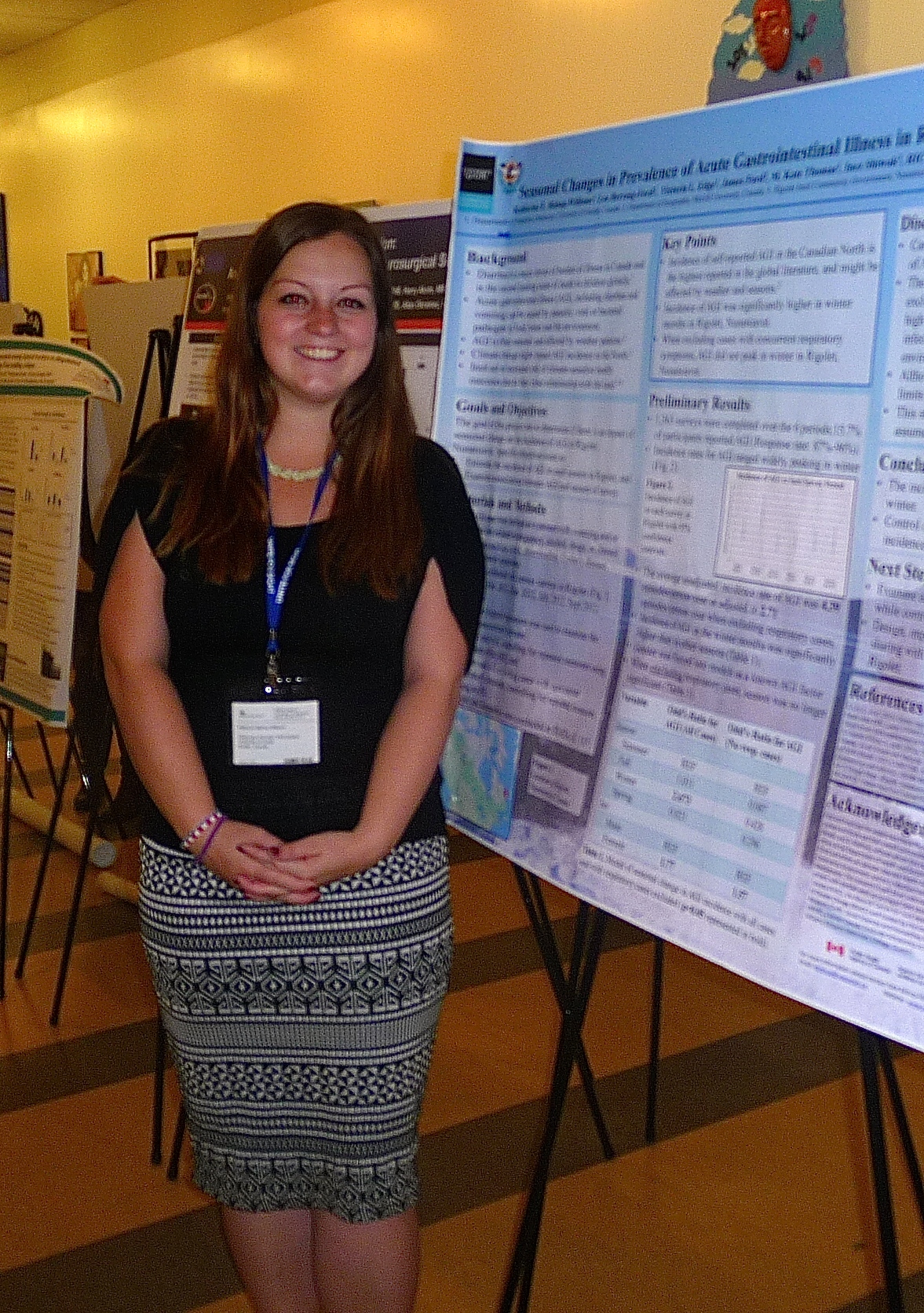Anna Bunce presented her work at the Canadian Anthropological Society (CASCA) annual meeting at University Laval in Quebec City last Wednesday. Her talk, titled "Inuit Women’s Berry Picking: Lessons on Gender, Procurement, Well-Being and the Environment/La cueillette de petits fruits chez les femmes inuites: leçons sur le genre, l’approvisionnement, le bien-être et l’environnement" explored the relationships Inuit women have with berry picking across Canada's north based on the findings of her own research along with that of Drs. Martha Dowsley (Lakehead University), and Scott Heyes (University of Canberra). Why has berry picking persisted among Inuit women? What role does berry picking play in the lives and identities of Inuit women? These questions were explored in the Re-Conception of Landscapes Session on May 13th.
New IHACC project article by Jolène Labbé in Mitigation and Adaptation Strategies for Global Change
Congratulations to Jolène Labbé for her newly published article in the latest edition of Mitigation and Adaptation Strategies for Global Change entitled "Vulnerability to the health effects of climate variability in rural southwestern Uganda". Read the abstract below, or click on the title above to access the article.
Abstract:
Vulnerability to the health impacts of climate change will be shaped by the existing burden of ill- health and is expected to be highest in poor and socio-economically marginalized populations. Sub-Saharan Africa, in particular, is considered a highly vulnerable region. This paper analyses the vulnerability and adaptive capacity of rural Bakiga communities in southwestern Uganda to climate-sensitive health risks. The objectives were threefold: i) identify key climate-sensitive, community-identified health priorities; ii) describe and characterize determinants of sensitivity to these health priorities at the individual, community and regional levels; and iii) assess the adaptive capacity of Bakiga. Data collection employed a combination of individual and key informant interviews, biographies, future storylines, and Photovoice. Three key health risks were identified by the study communities (malaria, food insecurity, and gastrointestinal illnesses) – all affected by local climatic and environmental conditions, livelihoods, land use changes, and socio-economic conditions. Adaptation within these communities is dependent on their capacity to reduce sensitivities to identified health challenges among the potential of increasing exposures. Crop diversification, reducing deforestation, expanding of livestock rearing, transfer of traditional knowledge, and access to affordable health services are among potential strategies identified. We demonstrate significant existing vulnerabilities to present day climate-related health risks and highlight the importance of non-climatic processes and local conditions in creating sensitivity to health risks. Our place-based understanding is useful to inform interventions or policies aimed to reduce exposure and sensitivity and support adaptive capacity as the conditions these communities face are consistent with many other sub-Saharan African countries.
Kate Bishop-Williams at the Yale University Global Health Conference on March 28th
On Saturday March 28th, Kate Bishop-Williams presented her research entitled Seasonal changes in prevalence of acute gastrointestinal illness and concurrent respiratory symptoms in Rigolet, Nunatsiavut, Canada at the Yale University Global Health Innovations Conference in New Haven, Connecticut. Kate’s abstract was selected as one of only 65 student posters from hundreds of submissions from across the United States and around the world.

Kate also had the opportunity to meet with former IHACC student researcher Joe Lewnard while at Yale University, and discuss experiences from past and present in Uganda.
New publication by IHACC collaborator Sarah Statham in Polar Record
We are happy to announce that IHACC collaborator Sarah Statham's Master's work has been published in the latest edition of Polar Record! Follow this link to read the article, entitled Anomalous climatic conditions during winter 2010–2011 and vulnerability of the traditional Inuit food system in Iqaluit, Nunavut. Abstract:
This study examines how climatic extremes during winter 2010–2011 affected the traditional food system in Iqaluit, Nunavut. This winter was anomalous throughout the Canadian Arctic, and manifested itself locally by warmer temperatures and decreased ice coverage. Drawing upon in-depth interviews with hunters (n = 25), a fixed question survey with public housing residents (n = 100), as well as analysis of remotely sensed sea-ice charts and temperature data from the Iqaluit weather station, this work identifies and characterises the extreme climatic conditions experienced, their subsequent effects on Iqaluit's traditional food system, and coping strategies used for dealing with food-related stresses. The results show increased environmental stress on the traditional food system compared to previous years. Freeze up occurred 59 days later than the average for the 1982–2010 period, while mean annual temperatures were 4.9ºC higher than the climatological mean, which negatively impacted hunters’ harvests and residents’ food supplies. Coping strategies alleviated some stresses, but adaptability was limited for financially insecure households reliant on income support. The study shows that when challenging socioeconomic conditions, such as those associated with public housing, are coupled with significant environmental stress, such as experienced during that winter, the vulnerability of the traditional food system is exacerbated. We suggest that winter 2010–2011 can be used as an analogue for exploring future food system vulnerabilities, with climate models projecting similar conditions in the coming decades.
Sierra Clark presented her work on AGI among the Batwa in southwestern Uganda at the Geography Honours poster session at McGill
 Sierra is presenting her honours thesis work looking at the burden, determinants and experience of self-reported acute gastrointestinal illness (AGI) among an indigenous Batwa-Pygmy population in southwestern Uganda at the Geography Honours poster session today at McGill University. We take this opportunity to congratulate Sierra on her thesis work. If you are interested in learning more about Sierra's work, please read her latest article, published in Epidemiology and Infection in December 2014:
Sierra is presenting her honours thesis work looking at the burden, determinants and experience of self-reported acute gastrointestinal illness (AGI) among an indigenous Batwa-Pygmy population in southwestern Uganda at the Geography Honours poster session today at McGill University. We take this opportunity to congratulate Sierra on her thesis work. If you are interested in learning more about Sierra's work, please read her latest article, published in Epidemiology and Infection in December 2014:
Clark, S., Berrang-Ford, L., Lwasa, S., Namanya, D.B., Edge, V.L., IHACC Research Team, and Harper, S. (2014).The burden and determinants of self-reported acute gastrointestinal illness in an Indigenous Batwa Pygmy population in southwestern Uganda. Epidemiology and Infection, [Epub ahead of print].
Abstract
Acute gastrointestinal illness (AGI) is an important public health priority worldwide. Few studies have captured the burden of AGI in developing countries, and even fewer have focused on Indigenous populations. This study aimed to estimate the incidence and determinants of AGI within a Batwa Pygmy Indigenous population in southwestern Uganda. A retrospective cross-sectional survey was conducted in January 2013 via a census of 10 Batwa communities (n = 583 participants). The AGI case definition included any self-reported symptoms of diarrhoea or vomiting in the past 2 weeks. The 14-day prevalence of AGI was 6·17% [95% confidence interval (CI) 4·2-8·1], corresponding to an annual incidence rate of 1·66 (95% CI 1·1-2·2) episodes of AGI per person-year. AGI prevalence was greatest in children aged <3 years (11·3%). A multivariable mixed-effects logistic regression model controlling for clustering at the community level indicated that exposure to goats [odds ratio (OR) 2·6, 95% CI 1·0-6·8], being a child aged <3 years (OR 4·8, 95% CI 1·2-18·9), and being a child, adolescent or senior Batwa in the higher median of wealth (OR 7·0, 95% CI 3·9-9·2) were significantly associated with having AGI. This research represents the first Indigenous community-census level study of AGI in Uganda, and highlights the substantial burden of AGI within this population.





